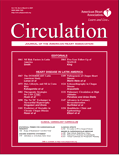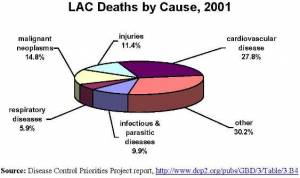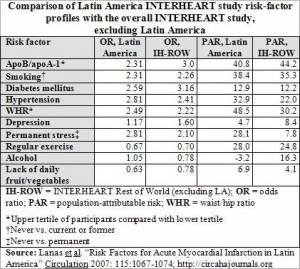« New Sections Added to the Reading List | Home | Eye on Ads: Energy Savings II »
Cardiovascular Disease in LAC Revisited
By Keith R | July 3, 2007
Topics: Advertising/Promotion, Food/Beverage Issues, Health Issues, Tobacco Control | No Comments »
Fellow bloggers, has this ever happened to you? You run across an important piece of news — a breakthrough study just released, for example — and are tempted to simply cut-and-paste into your blog the Reuters or other news blurb, or a related press release, or you’re tempted to make a “quick-and-dirty” post making (perhaps witty or snarky?) observations about the news. But you elect not to because you think you have something to add to news, some complementary information or insight. You do a quick draft or series of notes and ideas, and save it to your blog queue until you have time to flesh it out.
Weeks pass, either because you’re too busy to get back to it, or if you’re older and/or absent minded, you forget it’s there.
When you do remember it, you’re faced with a dilemma because you still don’t have the time to compose that full-bodied treatment you’d originally conceived. What to do? Ditch it and pretend you never intended to blog about it because it’s “old news”?
If it really was that important to begin with, the blogger doesn’t really want to do that. So what next? Relegate it to something equivalent to my Temas Reading List, so at least it’s on your blog site and might be read by surfers and caught by the search engines? Or own up to the tardiness, make the case for why it’s still relevant, and throw in what value-added you can in the time you have available, and hope it’s enough and that readers will appreciate it anyway?
Am I the only blogger that runs into this on a regular basis? 
One such piece below looks at an important study released in March on the risk factors for cardiovascular disease in Latin America. I put it on hold until I could write up a full-bodied piece on all the things going on around the region to address this issue, but unfortunately have not been able to do so and don’t want the piece to wait in queue any longer. I hope you’ll agree that the study remains worthy of discussion, and may help put into better perspective some of the other things you’ve been reading here on The Temas Blog these past few months.
 The INTERHEART Study Findings on Latin America
The INTERHEART Study Findings on Latin America
The 06 March 2007 issue of the technical journal Circulation (considered a leader in publishing cardiovascular research) featured a report on the findings for Latin America of the global INTERHEART study that examined 30,000 people in 52 nations.* INTERHEART is the first rigorous global study attempting to identify how risk factors for heart attacks different among various regions of the globe.
 Why does this matter? As I explained way back in my “Hearts and Minds” post, cardiovascular disease (CVD) has become the leading cause of death in Latin America and the Caribbean (LAC). Trouble is, while we have the statistics showing us its importance to LAC public health, until the INTERHEART study we only had theories, isolated studies, educated guesses and clinical observations to guide us as to the most important risk factors in the LAC context (yes, folks, the relative rank of risk factors does indeed vary among regions, countries and even population groups).
Why does this matter? As I explained way back in my “Hearts and Minds” post, cardiovascular disease (CVD) has become the leading cause of death in Latin America and the Caribbean (LAC). Trouble is, while we have the statistics showing us its importance to LAC public health, until the INTERHEART study we only had theories, isolated studies, educated guesses and clinical observations to guide us as to the most important risk factors in the LAC context (yes, folks, the relative rank of risk factors does indeed vary among regions, countries and even population groups).
The INTERHEART study looked at 1,237 cases of first acute myocardial infarction (heart attack) admitted to medical facilities and 1,888 age-, sex-, and center-matched control cases in Argentina, Brazil, Colombia, Chile, Guatemala and Mexico. The people in the control groups had no history of heart problems or chest pain.
 The study participants were surveyed about all sorts of factors, including history of diabetes, hypertension, smoking, alcohol consumption, and physical activity, plus psychosocial factors. Physical characteristics (such as waist-to-hip ratio) and blood pressure was also recorded and non-fasting blood samples were drawn and analyzed for apolipoproteins A-1 and B-100.
The study participants were surveyed about all sorts of factors, including history of diabetes, hypertension, smoking, alcohol consumption, and physical activity, plus psychosocial factors. Physical characteristics (such as waist-to-hip ratio) and blood pressure was also recorded and non-fasting blood samples were drawn and analyzed for apolipoproteins A-1 and B-100.
What did they find? For one, that abdominal obesity, abnormal lipids, and smoking (or as one LAC daily put it, big bellies, cholesterol and cigarettes) together account for 88% of population-attributable risk of heart attack in Latin America. Individually they account for 48.5%, 40.8%, and 38.4%, respectively.
Other significant risk factors found were persistent psychological stress, history of hypertension or diabetes mellitus.
The study also found that daily consumption of fruits and vegetables and regular exercise significantly reduce the risk of heart attacks among Latin Americans (surprise, surprise!).
The article’s authors suggest that their findings indicate that health authorities in Latin America should focus on programs at decreasing behavioral risk factors, lowering blood pressure and cholesterol.
Some bloggers and commentators looking at the press reports of the study quickly blamed it all on changes in diet from traditional LAC cuisine to imported “junk” and “fast” foods, but the study authors make no such claim. As much as I believe junk and fast foods contribute to CVD anywhere they become commonplace, I’m not so quick to shift all the blame to McDonald’s and Frito-Lay. Let’s be honest: many “traditional” dishes in LAC nations are laden with fat, salt, calories and cholesterol, and probably bear a significant portion of the blame too. Trouble is, we just didn’t have the hard data before to show the suspected correlation in LAC.
Also blamed have been an alleged lack of concrete efforts to combat smoking in the region. Indeed, there are many LAC nations that have done too little to combat tabaquismo (Colombia, Costa Rica, Dominican Republic, and Trinidad and Tobago spring readily to mind), but Uruguay has been a big success story, Argentina, Chile, Panama and Peru show signs of getting aggressive about it, most LAC nations have committed to implementing the WHO Framework Convention on Tobacco Control, and a regional forum of tobacco control officials has been formed to provide mutual aid in combating tabaquismo, so I see signs of that changing in the region.
The Costa Rican Study
In the same issue of Circulation there was an article** focusing on heart attack risk factors in Costa Rica that received no notice outside of the Tico press, and surprisingly little in the latter either. The study looked at 889 nonfatal myocardial infarction cases and 1,167 population-based control caes of Costa Ricans without a history of diabetes, hypertension or regular use of medication. Lifestyle and dietary variables were measured with validated questionnaires.
The findings? The two most important risk factors were obesity, with a population-attributable risk (PAR) of 29.3%, and smoking (25.6%) were the two greatest contributors. Other risk factors included caffeine intake (12.8%), physical inactivity (9.6%) and poor diet (6%).
Note how caffeine, a factor not mentioned in the INTERHEART study, plays a relatively large role in the Tico study, whereas inactivity and poor diet are lower contributors. What does it mean? I’m not sure, but think it might be worth further study.
The study also found that Tico women with heart trouble were more likely to have bad waist-to-hip ratios (35% vs. 9% for men), but Tico men more likely to smoke (31% vs. 10% for women). Many of the patients did not meet either WHO/FAO or American Heart Association (AHA) dietary guidelines: 95% got ? 7% of their energy from saturated fat, 25% had ? 5% of energy from polyunsaturated fat, 63% got ? 1% from trans-fat, and 53% had low fiber intake (<25 g/d).
What LAC is Doing About It All
I already noted above the region’s efforts to combat smoking. But there is more, including:
- The Pan American Health Organization’s (PAHO) campaign against trans-fat;
- The broader PAHO initiative broader “Get Moving America” campaign on physical activity and better dietary habits (I still have scheduled a blog post on this);
- Argentina‘s healthier lifestyle initiative;
- Chile‘s anti-“junk food” bill;
- Efforts in several Brazilian states (Amazonas, Ceará, Paraná, Rio de Janeiro) to ban or control certain foods in schools in the name of attacking childhood obesity, as well as the federal bills to restrict the advertising and promotion of foods and beverages linked to obesity, and to require restaurants and other eateries to disclose the caloric values of the foods and drinks they serve, and the national sanitary control agency’s (ANVISA) regulatory proposal to change advertising and promotion of high-energy, high-fat or high-sodium foods (I also have a blog post on this scheduled).
Is there more to do? Oh for sure, quite a lot. But it’s a start.
— Keith R
* Fernando Lanas, MSc, MD, et. al., for the INTERHEART Investigators in Latin America. “Risk Factors for Acute Myocardial Infarction in Latin America,” Circulation, 2007;115:1067-1074.
** Kabagambe, Edmond; Baylin, Ana; Campos, Hannia. “Nonfatal Acute Myocardial Infarction in Costa Rica: Modifiable Risk Factors, Population-Attributable Risks, and Adherence to Dietary Guidelines,” Circulation, 2007;115:1075-1081.
Tags: acute myocardial infarction, advertising, AHA, alcohol consumption, Amazonas, América Latina, Anvisa, Argentina, blood pressure, Brazil, caffeine, cardiovascular disease, Ceará, Chile, cholesterol, cigarettes, colesterol, Colombia, Costa Rica, diabetes, enfermedades cardiovasculares, fast food, Guatemala, heart attack, hipertensión, hypertension, infartos, INTERHEART, junk food, Latin America, lipids, Mexico, obesidad, obesity, OPS, PAHO, Paraná, physical activity, promotion, psychological stress, psychosocial factors, public health, Rio de Janeiro, salud pública, saude, smoking, tabagismo, tabaquismo, waist-to-hip ratio


